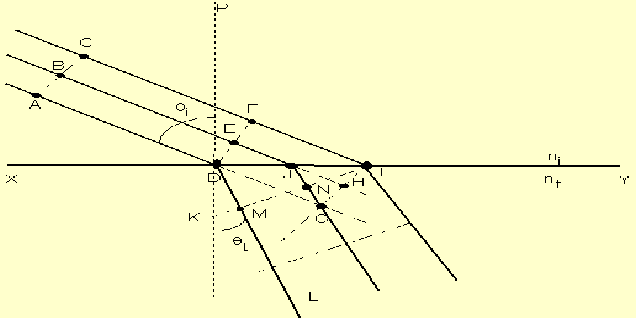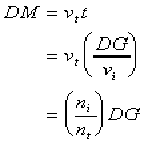Huygen's Principle states: Every point on a propagating wavefront serves as the source of spherical secondary wavelets, such that the wavefront at some later time is the envelope of these wavelets. If the propagating wave has a frequency, f, and is transmitted through the medium at a speed, v, then the secondary wavelets will have the same frequency and speed.
This principle is quite useful, for from it can be derived the laws of reflection and refraction. These are illustrated below.
Diffraction: Every point on a wavefront being a source of speherical waves, a wave can interfere with itself. At the edges this is less so, since the wavefront is truncated, leading to rounding at the edges.

Reflection: Part of the wavefront hits the reflecting surface and is reflected first The application of geometry then leads to the angle of incidence being equal to the angle of reflection.

Refraction: Both the speed of light and the direction of the light wave change direction.

If the speed of light in vacuum is![]() we express the speed in the upper medium by the ratio
we express the speed in the upper medium by the ratio![]() where
where![]() is the refractive index. Similarly, the speed of light in the lower medium is
is the refractive index. Similarly, the speed of light in the lower medium is![]() The points D, E, F on the incident wavefront arrive at points D, J and I of the plane interface XY at different times. In the absence of the refracting surface, the wavefront GI is formed at the instant ray DF reaches I. During the progress of ray CF from F to I in time t, however, the ray AD has entered the lower medium, where the speed is different. Thus if the distance DG is
The points D, E, F on the incident wavefront arrive at points D, J and I of the plane interface XY at different times. In the absence of the refracting surface, the wavefront GI is formed at the instant ray DF reaches I. During the progress of ray CF from F to I in time t, however, the ray AD has entered the lower medium, where the speed is different. Thus if the distance DG is![]() a wavelet of radius
a wavelet of radius![]() is constructed with centre at D; The radius DM can also be expressed as
is constructed with centre at D; The radius DM can also be expressed as
|
Similarly, a wavelet of radius![]() is drawn centred at J. The new wavefront KI includes point I on the interface and is tangent to the two wavelets at points M and N. The geometric relationship between the angles
is drawn centred at J. The new wavefront KI includes point I on the interface and is tangent to the two wavelets at points M and N. The geometric relationship between the angles![]() and
and ![]() formed by the representative incident ray AD and refracted ray DL is Snell's law which may be expressed as
formed by the representative incident ray AD and refracted ray DL is Snell's law which may be expressed as
![]()

